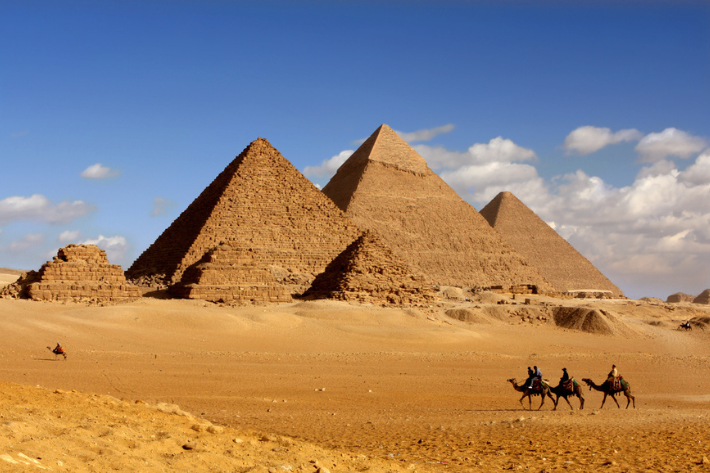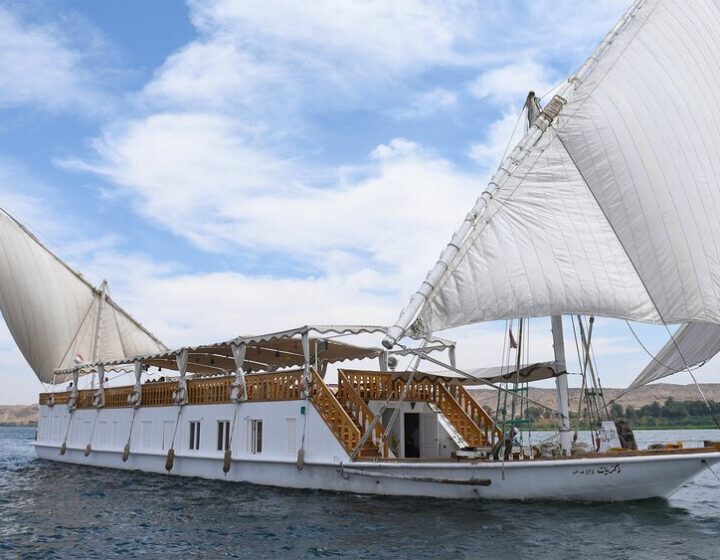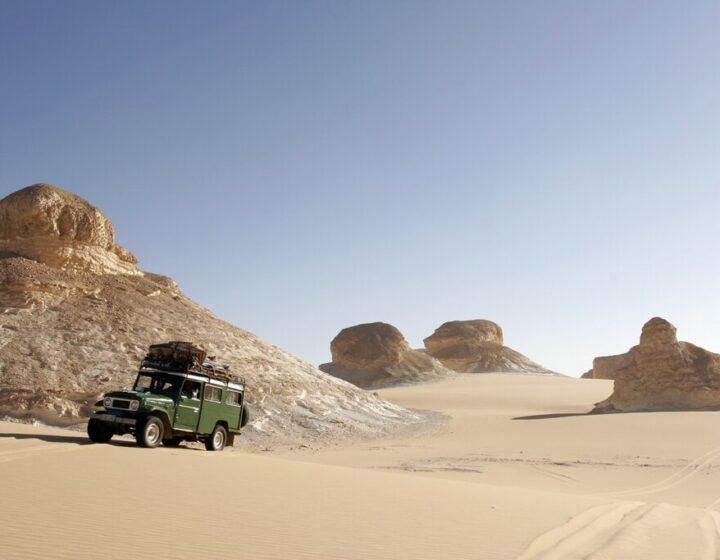Tour overview
Highlights
- Learn how to cook local delights, like koshary, on your first day in Egypt
- Take a day trip to the Temple of Seti I and Dendera Temple of Hathor
- See where royal women were buried in the Valley of the Queens
- Browse the labyrinthine alleys of the bustling Khan el-Khalili bazaar
- Glide down the dunes surrounding Fayoum on a sandboard
Brief Itinerary
| Day | Highlights | Overnight |
|---|---|---|
| Day 1 | Arrive in Cairo, Cooking Class in Giza | Giza |
| Day 2 | Visit the Giza Pyramid Complex, Overnight Train to Luxor | Giza |
| Day 3 | Explore the Karnak Temple Complex & Luxor Temple | Luxor |
| Day 4 | Visit the Temple of Seti I & the Dendera Temple of Hathor | Luxor |
| Day 5 | Discover the Valley of the Kings & Deir el-Bahari | Luxor |
| Day 6 | Explore Ramesses III’s Temple, Deir el-Medina & the Valley of the Queens | Luxor |
| Day 7 | Transfer to Aswan via the Temples of Edfu & Kom Ombo | Aswan |
| Day 8 | Visit the UNESCO-listed Abu Simbel Temples | Aswan |
| Day 9 | Full-Day Tour of Aswan, Felucca Ride on the Nile, Train to Giza | Giza |
| Day 10 | Tour the Egyptian Museum, Cairo Citadel & Old Cairo | Giza |
| Day 11 | Day Trip to Wadi al-Hitan & the Wadi el-Rayan Waterfalls | Giza |
| Day 12 | Visit the National Museum of Egyptian Civilization, Depart Cairo |
Day 1: Arrive in Cairo, Cooking Class in Giza
Welcome to Cairo, Egypt's vibrant capital. Meet your driver and transfer to your hotel in Giza, just 30 minutes outside Cairo. After refreshing, head to a local family's home to learn how to make delicious Egyptian cuisine. Share in the cooking and discover different ingredients as you help prepare traditional dishes, like falafel, kebab, or koshary—Egypt's national dish of rice, macaroni, lentils, and chickpeas topped with tomato sauce and crispy fried onions. When everything is ready, sit down to enjoy the meal together before ending the night with fruits and dessert.
Day 2: Visit the Giza Pyramid Complex, Overnight Train to Luxor (B)
Begin your full-day guided tour around the Giza Plateau (home to three of Egypt's most iconic pyramids) by starting at the Great Pyramid of Giza, the only survivor of the Seven Wonders of the Ancient World. Continue to the Pyramid of Khafre, the best preserved of the three pyramids, as the original stone still sits at the tip, and the Pyramid of Mycerinus, the smallest of the three. After admiring the exterior of each pyramid and exploring the inside where possible, head to the Great Sphinx, a colossal statue depicting a lion's body with a pharaoh's head.
Then, transfer 30 minutes to Saqqara, where the UNESCO-listed Saqqara Necropolis awaits your visit. Tour the archaeological site, stopping at the Pyramid of Djoser, the world's oldest stone building, built during the 27th century BCE. End the tour in Mit Rahinah to explore the ruins of Memphis, the capital of the Old Kingdom that once thrived here over 4,000 years ago. Walk through the open-air museum to see remnants of ancient temples, statues, and sphinxes. In the evening, head to the train station in Giza to catch an overnight sleeper train (with dinner) to Luxor, a city on the east bank of the Nile River.
Day 3: Explore the Karnak Temple Complex & Luxor Temple (B)
Enjoy breakfast on the train, then meet your Egyptologist guide outside the station in Luxor to set off on a private tour of the East Bank's landmarks. Start at Karnak, the second largest temple complex in the world, after Angkor Wat in Cambodia. Walk down the Avenue of Sphinxes, lined with well-preserved sphinx statues, and enter the sprawling 250-acre (100 ha) complex. Wander through the Great Court, where colossal statues of pharaohs and gods stand, then continue deeper to the Hypostyle Hall to see the towering columns adorned with elaborate hieroglyphs.
After exploring the complex, follow what's left of the Avenue of Sphinxes to the entrance of Luxor Temple, which served as a focal point for religious worship and celebration during the New Kingdom period. Look at the towering pillars adorned with engravings depicting scenes from Egyptian mythology and history, then step through the monumental gateway. Admire the chapels and shrines dedicated to different deities, stopping at the inner sanctuary, where the statue of the god of the air, the sun, and creation, Amun-Ra, was once housed before heading to your hotel in Luxor to rest.
Day 4: Visit the Temple of Seti I & the Dendera Temple of Hathor (B)
Leave Luxor behind for the day as you transfer 2.5 hours north along the Nile to Abydos, one of the oldest cities of ancient Egypt. When you arrive, head straight to the Temple of Seti I, built during the New Kingdom period as a testament to the power and piety of Pharaoh Seti I. As you approach the temple's entrance, you'll be greeted by a monumental facade adorned with intricately carved reliefs and hieroglyphs depicting scenes from Egyptian mythology and the pharaoh's divine lineage.
Wander through the dimly lit corridors and halls until you reach the Hypostyle Hall, with its towering columns and exquisite carvings, including the famous Abydos King List, which depicts the names of pharaohs from Egypt's earliest dynasties. Then, on your way back to Luxor, stop at the Dendera Temple of Hathor, which dates from the Old Kingdom period and is dedicated to the goddess of the sky, women, fertility, and love. Wander the labyrinthine halls, chapels, and sanctuaries to see the colorful paintings and bas-reliefs before transferring one hour back to Luxor
Day 5: Discover the Valley of the Kings & Deir el-Bahari (B)
Today, you'll discover Luxor's West Bank with your tour driver, starting with breakfast and then a visit to the Valley of the Kings, just 30 minutes outside the city. This UNESCO-listed necropolis was the burial site for many famous noblemen and pharaohs, including Tutankhamun. Stop at three tombs to witness their elaborate resting places and learn more about ancient Egypt's afterlife beliefs and royal rituals. Admire the hieroglyphs adorning each tomb, depicting the occupant's journey to the afterlife and their encounters with gods and goddesses.
Head up to the adjacent Deir el-Bahari, a complex of mortuary temples dedicated to Queen Hatshepsut set against the towering cliffs. Admire the expansive terraces, colonnaded halls, and intricately carved reliefs celebrating the queen's divine right to rule. Then, step inside to wander through the sacred sanctuaries and chapels until you reach the grand terrace, where you'll enjoy panoramic views of the surrounding landscape. After exploring the tombs and temples, return to your hotel in the city to relax.
Day 6: Explore Ramesses III's Temple, Deir el-Medina & the Valley of the Queens (B)
Join your guide for another day of exploring Luxor's West Bank, venturing 30 minutes to Medinat Habu, a sprawling archaeological complex. The highlight of the ruins is the Mortuary Temple of Ramesses III, one of Egypt's most powerful pharaohs. Step through the temple's monumental gateway to view the towering columns, colossal statues, and vast courtyards revealing the complex's former glory. Enter the inner sanctuary to see the well-preserved reliefs depicting scenes from Ramesses III's military campaigns, religious rituals, and royal processions.
Continue to Deir el-Medina, an ancient Egyptian village once inhabited by the craftspeople who built the royal tombs in the Valley of the Kings. Stroll through the remains of mud-brick houses, workshops, and burial sites to gain insight into the community that thrived here over 3,000 years ago. End the tour at the Valley of the Queens, the final resting place of queens, princesses, and other royal family members during the New Kingdom period. Step inside the intricately decorated tombs lined with colorful reliefs, stopping at the tomb of Nefertari, Ramesses II's wife, before returning to your hotel.
Day 7: Transfer to Aswan via the Temples of Edfu & Kom Ombo (B)
Say goodbye to Luxor this morning as you set off on a three-hour transfer south to Aswan, a city on the Nile River. On the way, stop halfway at the Temple of Edfu, dedicated to Horus, the falcon-headed god of kingship, healing, protection, the sun, and the sky. Admire the massive facade of one of the largest temples in the country, then step inside to see the towering columns engraved with scenes depicting the triumph of good over evil in the eternal battle between Horus and his nemesis, Seth.
Back in the car, enjoy a packed lunch before stopping at the Temple of Kom Ombo, a double temple dedicated to Horus and the god of the Nile, fertility, and crocodiles, Sobek. Explore the twin sanctuaries, courtyards, and halls in both temples, visiting the Hypostyle Hall to see the rows of columns adorned with intricate carvings and colorful paintings. Complete the one-hour drive to Aswan, where you can settle into your hotel and enjoy the rest of your evening at leisure.
Day 8: Visit the UNESCO-listed Abu Simbel Temples (B)
Today's journey takes you 3.5 hours south to the UNESCO-listed Abu Simbel Temples, nestled on Lake Nasser. Built during the reign of Pharaoh Ramesses II in the 13th century BCE, these monumental temples are dedicated to the gods Amun, Ra-Horakhty, and Ptah, as well as Ramesses and his wife, Nefertari. Admire the four colossal statues of Ramesses II seated on thrones, each over 65 feet (20 m) tall. Then, step inside the grand Hypostyle Hall, supported by more statues of the king and adorned with vibrant paintings depicting offerings to the gods and sacred rituals.
Deeper in the complex, you'll find seated statues of the gods and intricate carvings detailing the pharaoh's devotion to them. Exit the main temple to explore the smaller yet equally majestic temple dedicated to Queen Nefertari and admire the ancient craftsmanship up close. Look for the vibrant paintings of the queen's life and eternal presence alongside the gods to learn more about her role. After exploring both temples, return to your hotel in Aswan for the night.
Day 9: Full-Day Tour of Aswan, Felucca Ride on the Nile, Train to Giza (BB)
Your last day in Aswan takes you to some of the city's main highlights, starting at the Aswan High Dam, an engineering marvel built in 1960 to protect Egypt from floods, increase cultivable land, and double the country's electricity supply. Visit the Unfinished Obelisk next, a colossal 137-foot (42 m) long structure that still resides in the stone quarry where it was being carved. After walking around the largest known ancient obelisk, jump on a boat and cruise to Philae Temple on Agilkia Island. Disembark and wander through the temple dedicated to the goddess of love, healing, fertility, magic, and the moon, Isis.
As you approach the entrance, admire the grand colonnaded courtyard, then step inside the inner sanctuary and sacred precincts to learn more about Isis and her importance in ancient Egyptians' religious beliefs. Next, hop on another boat, called a felucca, to explore the Nile in style. Glide across the tranquil waters in the traditional wooden sailboat, passing lush palm groves, ancient temples, and Nubian villages. In the evening, head to the station to catch an overnight train back to Giza. When you arrive in the early morning, meet your driver outside the station and transfer to your hotel to rest.
Day 10: Tour the Egyptian Museum, Cairo Citadel & Old Cairo (B)
After a rest at your hotel, set off on a full-day tour of Cairo, starting at the Egyptian Museum, which houses over 120,000 genuine artifacts spanning over 5,000 years. Wander through the grand halls to admire the intricately carved statues of pharaohs and gods, ancient manuscripts, and Tutankhamun's collection of treasure, gold, and jewelry, enclosed in his tomb for over 3,500 years before it was discovered in the 1920s. Continue to the Cairo Citadel, a stronghold built atop the Muqattam Hills to protect the city from Crusader attacks.
View the ancient ramparts, towering bastions, and delicate carvings adorning the walls until you reach the Mohamed Ali Mosque, also known as the "Alabaster Mosque." Renowned for its elegant domes, towering minarets, and pristine marble facade, the mosque offers a respite from the bustling streets below. Your next stop is Old Cairo for a stroll down the pedestrian-only Al-Muizz li-Din Allah al-Fatimi Street. Pass historic mosques, mausoleums, and palaces to arrive at Khan el-Khalili, a bustling 14th-century bazaar where you'll find an abundance of handmade goods and local delights.
Day 11: Day Trip to Wadi al-Hitan & the Wadi el-Rayan Waterfalls (B)
Trade the city for the desert this morning as you set off on a three-hour transfer to Wadi al-Hitan, also known as "Whale Valley," as the fossilized remains of the earliest suborder of whales, archaeoceti, were found here. Wander through the UNESCO-listed valley and look at the towering sandstone cliffs, wind-sculpted rock formations, and rugged desert terrain. Your guide will take you to see 40-million-year-old fossilized whale skeletons embedded in the rock layers so you can imagine the creatures that once inhabited this prehistoric sea.
Continue to the Wadi el-Rayan Waterfalls in the heart of the desert. Despite the arid surroundings, the waterfalls were formed in 1970 by overflowing drainage water from the farmlands in Fayoum. Go for a swim in the crystal-clear pools beneath the falls or bask in the sun on the shores surrounded by the cool mist. Then, grab a sandboard and glide down the golden slopes of the nearby dunes. Enjoy a late lunch at a local restaurant, then transfer back to your hotel in Giza to relax.
Day 12: Visit the National Museum of Egyptian Civilization, Depart Cairo (B)
Take advantage of your final few hours in Egypt with a guided visit to the National Museum of Egyptian Civilization to learn more about the country's diverse history, spanning over 4,000 years. Step inside the grand halls and browse the wealth of artifacts, from ancient relics and monumental statues to intricately decorated tombs and glittering jewelry. After lunch, go on a tour of Coptic Cairo, an area in Old Cairo that was a stronghold of Christianity both before and during the Islamic era.
Pass iconic landmarks like Saint Virgin Mary's Coptic Orthodox Church, better known as the "Hanging Church," as its nave is suspended above a Roman fortress gatehouse, giving it the illusion of hanging over the street below. Stop at the Church of St. Sergius and Bacchus, believed to be the site where the Holy Family sought refuge during their flight into Egypt. You'll also see the Ben Ezra Synagogue, originally a Christian church dating back to the ninth century. When it's time, transfer to the airport for your flight home. Safe travels!





